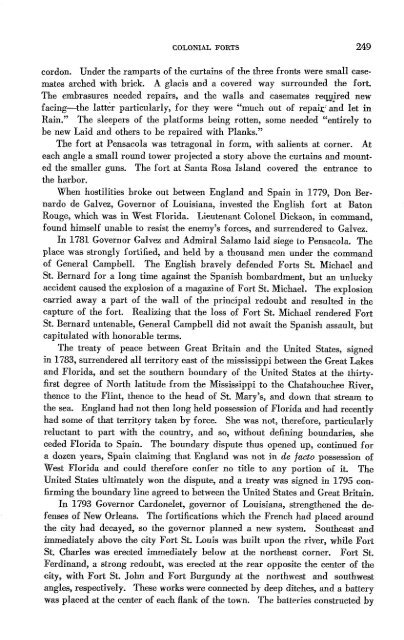THE COAST ARTILLERY JOURNAL - Air Defense Artillery
THE COAST ARTILLERY JOURNAL - Air Defense Artillery
THE COAST ARTILLERY JOURNAL - Air Defense Artillery
Create successful ePaper yourself
Turn your PDF publications into a flip-book with our unique Google optimized e-Paper software.
COLONIAL FORTS 249<br />
cordon. Under the ramparts of the curtains of the three fronts were small casemates<br />
arched with brick. A glacis and a covered way surrounded the fort.<br />
The embrasures needed repairs, and the walls and casemates reqgJred new<br />
facing-the latter particularly, for they were "much out of repair' and let in<br />
Rain." The sleepers of the platforms being rotten, some needed "entirely to<br />
be new Laid and others to be repaired with Planks."<br />
The fort at Pensacola was tetragonal in form, with salients at corner. At<br />
each angle a small round tower projected a story above the curtains and mounted<br />
the smaller guns. The fort at Santa Rosa Island covered the entrance to<br />
the harbor.<br />
When hostilities broke out between England and Spain in 1779, Don Bernardo<br />
de Galvez, Governor of Louisiana, invested the English fort at Baton<br />
Rouge, which was in West Florida. Lieutenant Colonel Dickson, in command,<br />
found himself unable to resist the enemy's forces, and surrendered to Galvez.<br />
In 1781 Governor Galvez and Admiral Salamo laid siege to Pensacola. The<br />
place was strongly fortified, and held by a thousand men under the command<br />
of General Campbell. The English bravely defended Forts St. Michael and<br />
St. Bernard for a long time against the Spanish bombardment, but an unlucky<br />
accident caused the explosion of a magazine of Fort St. Michael. The explosion<br />
ca.rried away a part of the wall of the principal redoubt and resulted in the<br />
capture of the fort. Realizing that the loss of Fort St. Michael rendered Fort<br />
S1.Bernard untenable, General Campbell did not await the Spanish assault, but<br />
capitulated with honorable terms.<br />
The treaty of peace between Great Britain and the United States, signed<br />
in 1783, surrendered all territory east of the mississippi between the Great Lakes<br />
and Florida, and set the southern boundary of the United States at the thirtyfirst<br />
degree of North latitude from the Mississippi to the Chatahouchee River,<br />
thence to the Flint, thence to the head of St. Mary's, and down that stream to<br />
the sea. England had not then long held possession of Florida and had recently<br />
had some of that territ9ry taken by force. She was not, therefore, particularly<br />
relnctant to part with the country, and so, without defining boundaries, she<br />
ceded Florida to Spain. The boundary dispute thus opened up, continued for<br />
a dozen years, Spain claiming that England was not in de facto possession of<br />
West Florida and could therefore confer no title to any portion of it. The<br />
United States ultimately won the dispute, and a treaty was signed in 1795 confirming<br />
the boundary line agreed to between the United States and Great Britain.<br />
In 1793 Governor Cardonelet, governor of Louisiana, strengthened the defenses<br />
of New Orleans. The fortifications which the French had placed around<br />
the city had decayed, so the governor planned a new system. Southeast and<br />
immediately above the city Fort St. Louis was built upon the river, while Fort<br />
St. Charles was erected immediately below at the northeast corner. Fort St.<br />
Ferdinand, a strong redoubt, was erected at the rear opposite the center of the<br />
city, ",,-jthFort St. John and Fort Burgundy at the northwest and southwest<br />
angles, respectively. These works were connected by deep ditches, and a battery<br />
was placed at the center of each flank of the town. The batteries constructed by
















